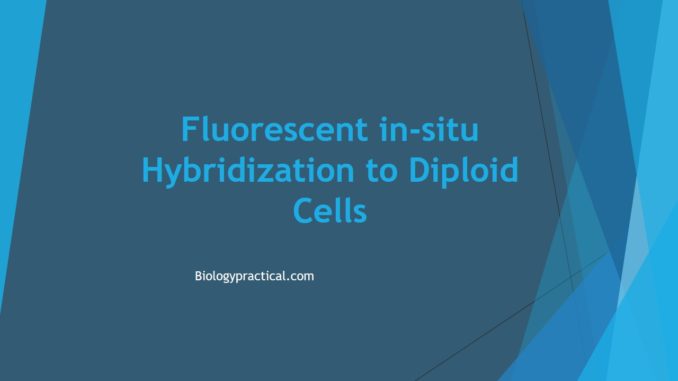
Protocol of in-situ hybridization
- In situ hybridization to diploid cells serves in mapping and characterizing the behaviour of heterochromatic sequences of Drosophila, which are both under represented and aggregated in polytene cells.
- Two protocols are included for in situ hybridization to diploid cells from squashed and whole-mounted third-instar larval brains.
- For genome mapping, squashed preparations are preferred as they are easy to make and provide the highest possible resolution.
- The procedure can be employed either in untreated brains or in brains where the number of mitotic chromosomes has been artificially increased by incubation with colchicine.
- Whole mounted protocol should be carried out when more functional studies are to be performed .
- Whole-mounted tissues conserve the original three-dimensional arrangement of subcellular organelles and are devoid of the artefacts produced by squashing.
- These are necessary requirements needed to study problems like chromosome pairing, chromosomal domains in interphase nuclei, attachment sites, and many others.
Fluorescent in-situ Hybridization to Squashed Diploid Cells:
- Obtaining brain of larvae:
- With a pair of tweezers, brains are obtained from third-instar larvae by pulling from the mouth parts while holding the larvae by their middle.
- The brain (ventral ganglion plus optic lobes) usually comes out together with the salivary glands and other internal tissues.
- Carefully remove other tissues as brain preparations devoid of other tissues are essential to obtain good squashes.
- Dissect out larval brains in 0.7% NaCl and incubate in 0.5 kg/ml colchicine in 0.7% NaCl in a dark, humid chamber for 2 hours.
- Apply hypotonic shock by washing in 0.5% trisodium citrate for 10 minutes.
- Place the dissected brains on a microscope slide, add a drop of 45% acetic acid, and leave for 30 seconds.
- Remove the liquid using tissue paper, add a drop of 60% acetic acid, and cover with a 18 X 18 mm2 coverslip.
- Do not squash yet, but wait for 3 minutes.
- Squash between two sheets of blotting paper by pressing with two fingers on opposite comers.
- Keep pressing for at least 10 seconds and release pressure gently. Repeat, pressing on the other two comers.
- Immerse the end of the slide carrying the coverslip in liquid N2.
- When the nitrogen ceases to boil, remove the slide and level off the coverslip with the flick of a scalpel.
- Dehydrate by successive immersion of the slide in 70% ethanol for 3 minutes, 100 %ethanol for 3 minutes, and air dry before use.
- Bake the slide at 58°C for 1 hour in a dry oven.
- Immerse slides in H2O gently to remove the coverslips.
- Denature the chromosomal DNA by boiling for 3 minutes.
- The slides should be kept in hot (>80°C) water until the probe is applied.
- Apply 10 µl denatured probe and carry out the hybridization at 58°C in a humid chamber overnight
- After hybridization, carry out the washing and Fluorescein isothiocyanate (FITC) staining.
Fluorescent in Situ Hybridization to Whole-Mounted Diploid Tissues
- Dissect brains in saline.
- Fix for 10 minutes in formaldehyde 3.7% in saline.
- Transfer to an Eppendorf tube and add about 500
µl of 37% formaldehyde and 200
µl of n-heptane.
- Incubate for 20 minutes in spinning wheel at room temperature.
- Remove all the heptane and as much formaldehyde as possible, add 500
µl of 1% triton X-100 in PBS, and incubate for 20 minutes.
- Remove supernatant and wash once in phosphate-buffered saline (PBS)
- Add 50
of probe and cover with 50 parafilm oil.
- Denature in boiling water bath for 10 minutes and incubate overnight at 58°C.
- Add 4X saline sodium citrate (SSC) under the oil and remove as much oil as possible.
- Wash for 10 minutes in 4X SSC.
- Wash for 10 minutes 4X SSC + 0.1% triton X-100.
- Wash for 10 minutes in 4X SSC.
- Incubate in 150 FITC-avidin in 4X SSC for 30 minutes at room temperature and repeat washes as in steps 10 to 12.
- Incubate in 1
propidium iodide in 4 X SSC for 10 minutes.
- Wash for 10 minutes in 4X SSC.
- Mount in glycerol-propyl gallate.
